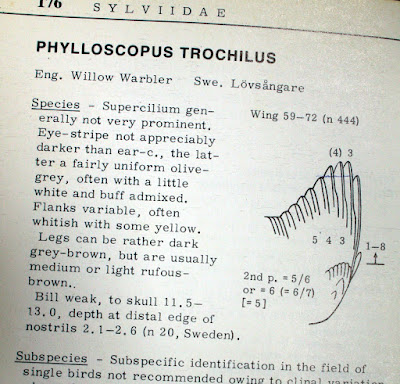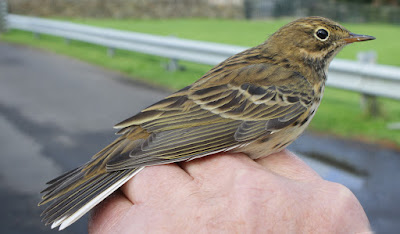Expectations were high this morning. Monday afternoon, evening and overnight had been clear and warm, perfect conditions for migrant birds setting out on a long journey. Or so we hoped. I met up with Andy before 0600 to a clear sky and zero wind. We were joined today by Bryan.
After a slow start birds began to appear with a decent amount of visible migration heading south in the shape and sounds of 45+ Swallow, 8 Sand Martin, 30+ Meadow Pipit, 20 Tree Pipit, 12 Pied Wagtail, 2 Grey Wagtail, 2 Spotted Flycatcher and uncounted but small numbers of Chaffinch.
In the main we targeted pipits, wagtails and warblers and finished at midday with a catch of 45 birds and a mix of 13 species.
It was pipits that topped the charts today, not the common Meadow Pipit, instead the less abundant Tree Pipit at the peak of the species’ autumn migration timetable and following an apparently successful breeding season. In contrast to Tree Pipits whose migration will be over by September, the migration of Meadow Pipits is just beginning and will last into October.
Totals - 11 Tree Pipit, 2 Meadow Pipit, 8 Willow Warbler, 4 Chaffinch, 3 Chiffchaff, 3 Goldcrest, 3 Wren, 3 Robin, 3 Blue Tit, 2 Great Tit, 1 Blackcap, 1 Bullfinch, 1 Lesser Redpoll.
Tree Pipit
Meadow Pipit
Bullfinch
Chiffchaff
Chaffinch
Bullfinch
Goldcrest
And now for news and a precautionary tale about crows that live in the city.
Apparently, and according to a new study, researchers recently found that American Crows living in urban settings have higher blood cholesterol levels than their rural peers. The crows’ higher cholesterol levels came about after they picked up the eating habits of their human neighbours by eating discarded pizza slices and tossed-out cheeseburgers.
American Crow
For the study, published just last week in the journal The Condor: Ornithological Applications, scientists measured the blood cholesterol levels of 140 crow nestlings living along an urban-to-rural beat in California. Researchers also supplied rural nestlings in New York with McDonald's cheeseburgers. The burgers were a huge success with the birds, and some gobbled as many as three a day. Other adult crows would bring home burgers to their nestlings or store them for later.
Like the city-bred crows tested in California, the New York nestlings developed higher cholesterol levels than their fast food-free peers.
Though urban birds didn't live as long as their rural peers, on average, cholesterol wasn't to blame.
"Despite all the bad press that it gets, cholesterol has benefits and serves a lot of essential functions," study author Andrea Townsend, a researcher at Hamilton College in New York, said in a news release. "It's an important part of our cell membranes and a component of some crucial hormones. We know that excessive cholesterol causes disease in humans, but we don't know what level would be excessive in a wild bird."
Still, researchers don't recommend providing birds with fast food. "Wild birds haven't evolved to eat processed food, and it might have negative consequences that we didn't measure, or that will only show up over longer periods of time," Townsend said. "Feeding wild birds can be a great way to connect with nature, and it can be a refreshing change to think that we're doing something that helps animals out. At the same time, though, I do worry that some of the foods that humans give to wild animals, and living in an urban environment in general, might not be good for their health."
Burger
Friends, you have been warned. Stick to peanuts and bird seed and ditch the junk food. You know it makes sense.

















































































